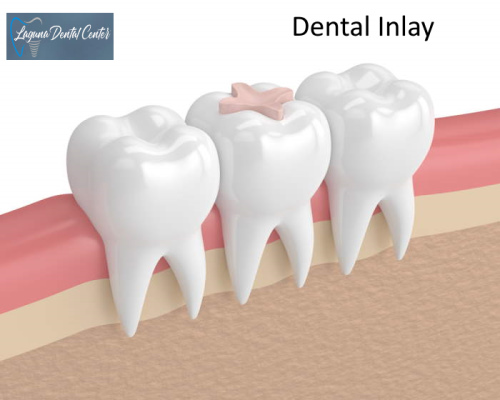Table of Contents

What is a Dental Inlay?
A dental inlay uses a prefabricated filling to restore a severely decayed or fractured tooth. It is a solitary, reliable repair to properly fit a cavity’s shape. The pits and fissures on the chewing surface of a tooth are filled with an inlay.
How is a Dental Inlay done?
A custom-made filling is placed in the area of your mouth that is damaged during the dental inlay process to restore the tooth. The procedure helps to protect the decayed tooth and prevent further harm.
- The decay is carefully eliminated without entering the pulp chamber of the teeth.
- There is a temporary filler put in.
- A dental lab makes a final inlay just for you, so it fits flawlessly.
- The final inlay is cemented into place after a temporary filler is removed.
Make an Appointment with Dr. Ronald Ayzin at Laguna Dental Center to See if You Need Dental Inlay.
Call us at (949) 704-6269 to schedule an appointment.
- FREE Tooth Inlay Consultation ($100 Value).
- FREE Digital X-rays especially for Porcelain Inlay ($150 Value).
- We Maximize your Insurance so you pay less out of pocket.
Contact Us:
What are Dental Inlays made of?
- Gold – offers the greatest longevity and predictability. Compared to porcelain, gold is gentler on opposing tooth surfaces and needs less tooth structure to be removed. The absence of the natural tooth color is a drawback.
- Porcelain – Provides the best esthetic result if the treatment area is within the “smile zone.” Porcelain is also incredibly durable, but if a patient grinds or clenches their teeth, it might wear down neighboring teeth.
- Composite resin – Compared to porcelain and gold dental inlays, composite resin is used less frequently, however certain dentists may offer it as an option. Due to its increased strength and capacity to more successfully fill bigger cavities, this is utilized as an alternative to a conventional dental filling.
- Ceramic – made of stronger, longer-lasting materials than dental fillings and crowns. They often last longer and offer more strength and support to teeth that are broken. It is more costly than other materials, though.
When is a Dental Inlay Needed?
Dental inlays and Onlays are needed for fractured back teeth that do not yet require a crown. These dental restorations often repair broken, fractured, or decaying teeth when the damage is modest to moderate.
How Long Does a Dental Inlay Last?
A literature study published in the Journal of Dental Health states that a dental inlay and onlay repair method lasts for 20 to 30 years before needing to be replaced. If the right aftercare and instructions are followed, your restorations’ lifespan can be extended.
What are the Advantages of Dental Inlays?
- While crowns need more tooth excision, dental inlays preserve tooth integrity.
- Since inlays are made in a lab and then cemented into place, they provide a superior repair than a large filling.
- They are more appealing than a huge silver (amalgam) filling.
- They get stronger after they are linked to your tooth.
What are the Disadvantages of Dental Inlays?
- Dental inlays take a long time to prepare and install.
- They cost roughly as much as a crown and more than a filling.
- Since many more exposed edges might come into touch with bacterial plaque during treatment, the patient needs to practice great oral hygiene.
- They are only the restoration of choice if you grind your teeth if made with gold.
What does an Inlay Before and After look like?
What are the Aftercare Tips for Porcelain Inlays?
- Brush your teeth twice daily to eliminate food residue and the acids that oral bacteria produce.
- One daily flossing session contributes to cleaning inter dental areas.
- Mouthwash helps clean places where brushing and flossing miss.
How much does a Dental Inlay cost?
Each tooth’s dental inlay costs from $650 to $1,200. Since inlay and Onlay procedures are designed to restore damaged teeth, most insurance policies, fortunately, cover all or some of the related costs.
FAQs for Dental Inlay
Those who have enough healthy teeth to avoid requiring a crown but too much damage or decay to be fixed with a filling make excellent candidates for dental inlays.
Additionally, an inlay process often needs two visits. During your initial visit, several precise impressions (molds) will be made to produce your bespoke inlay and a temporary repair.
Does getting an Inlay hurt?
No, an inlay dental surgery is quick and painless. Before drilling into the decayed tooth to remove it, your dentist will first numb the afflicted region of your mouth using a local anesthetic.
Are Dental Inlays worth it?
Yes. For fractured back teeth that do not yet require a crown, dental onlays and inlays are necessary. These dental restorations often repair broken, fractured, or decaying teeth when the damage is minor or moderate. Neglecting your damaged teeth can lead to subsequent treatments that are more costly and uncomfortable.
Areas We Serve:

